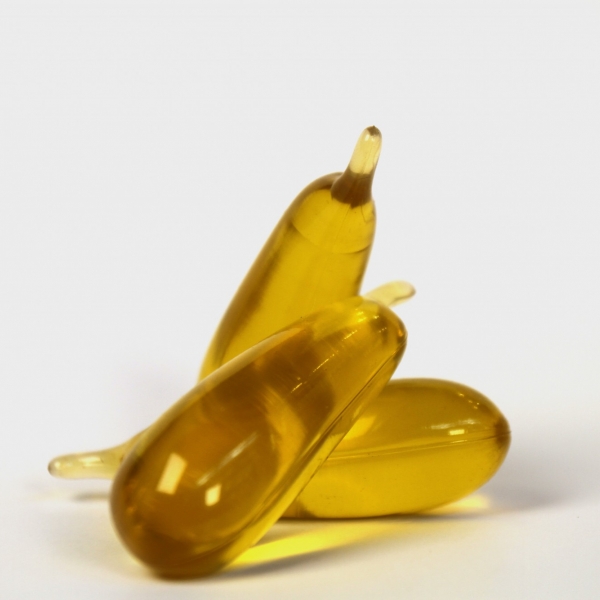
These wonderfully uddery, olive oil-filled pipettes are made from a seaweed bioplastic that is both edible and biodegradable.
Seaweed has been used in Asian cuisines and medicines for centuries, but has much more recently become popular as a source of biomass in the agriculture, pharmaceutical, and biofuel industries. It has also piqued the interest of packaging producers, as well as numerous artists and designers.
In 2010 the company Algopack was the first bioplastics company to use seaweed to make plastic food packaging. They were closely followed by a whole host of other start-ups and small companies like Loliware, who made edible cups and straws; Evoware, who made edible films and packaging for dried foods; and Notpla, the makers of these golden, oil-filled pipettes. Notpla cut their teeth on their first product for marathon runners in 2019 with Ooho!: an edible and biodegradable seaweed-based membrane sphere filled with water. This ‘water ball’ made use of the process of spherification, a culinary technique made famous by chef Ferran Adrià of elBulli. The water ball could be consumed in its entirety, or a small hole could be made to pour the water out, leaving only a biodegradable film that could break down in home compost in 10 days.
Seaweed has also generated a lot of interest amongst artists and designers. In 2013 Julia Lohmann, Professor of Contemporary Design at Aalto University, established the Department of Seaweed, a transdisciplinary community of practice exploring the marine organisms’ potential as a design material. She was inspired by her encounter with lengths of edible, veneer-like konbu in a fish market in Sapporo, Japan and ‘started imagining a world of everything being made of seaweed’. Since then, numerous designers and researchers have experimented with making super-soft and flexible seaweed leathers (the recipes for which often seem to be a closely-guarded secret), yarns that can be knitted into trainers or socks, and even mould- and fire-resistant insulation and bricks for the built environment.
Seaweed bioplastics make use of the seaweed-derived polysaccharides alginate, agar, and carrageenan, whose gelling abilities make them very suitable for the development of coatings and films. Alginates are mainly extracted from brown algae whereas agar and carrageenan are extracted from certain types of red algae. Makers of seaweed bioplastics cite the benefits that these macroalgae don’t need fertilisers, pesticides, herbicides or lots of land, that they grow quickly and plentifully in coastal areas, and that the resulting bioplastics biodegrade within twelve weeks in soil and five hours in water. Seaweeds and kelps are also known to absorb large quantities of CO2 from the atmosphere: up to five times more than any other land plant. Seaweed bioplastics are also though to exhibit antimicrobial properties, as seaweeds produce antimicrobial compounds that help them to survive in harsh marine environments.
However, as numerous researchers have pointed out, unless it is done sensitively, intensive farming of seaweed on a large scale can have its own environmental impacts. Once production moves from wild harvesting to aquatic or land-based seaweed farming, impacts on local ecosystems need to be considered. The drive to make production more efficient and improve the quality and consistency of seaweed produced also involves energy and water consumption, as well as interventions to control environmental conditions and diseases, all of which have environmental impacts.
There are also questions about the realities of what happens to compostable plastics in our current waste and recycling systems (see the UCL Plastics Waste Hub for more information) and the practicalities of hygienically transporting edible packaging. Asian rice candy comes up frequently in edible-packaging discussions: the gooey sweet and rice paper package are both double-wrapped in an outer layer of plastic or wax paper. This double layer of packaging illustrates a conundrum with edible packaging or tableware: if consumers are expected to eat it, it needs to be protected from dust, germs, and other contaminants.
Whilst materials like these beautiful, algal globules of bioplastic do have the potential to mitigate climate change, the chewy issues surrounding them illustrate that there is no such thing as a 'sustainable material', only sustainable systems. We need to consider a material's whole life cycle, from production through to use and disposal, in order to fully understand its environmental impacts.
Sample ID: 1467
Particularities
- Maker
- Notpla
- Selections
- Curiosities
- Biomimetic | Edible
- Relationships
- Biodegradable | Bioplastic | Compostable | Edible | Film | Packaging | Plastic | Seaweed | Yellow
Add materials you find interesting to your own selections.
Use the  button to select a material and get started.
button to select a material and get started.



